El Niño is a weather pattern that occurs in a region of the eastern Pacific Ocean near the equator. It usually happens once every two to seven years, according to National Geographic.
The name El Niño means "the boy," compared to "the girl," or La Niña. But where La Niña brings colder surface temperatures, El Niño means things are heating up — a condition that affects the climate worldwide.
How El Niño works
National Geographic explains the conditions that cause El Niño. Normally, strong currents of air called "trade winds" blow from east to west over the Pacific. Matching ocean currents push the warmest water at the ocean's surface from South America toward Australia and Southeast Asia.
During El Niño, though, the trade winds get much weaker, air pressure over the Pacific decreases, and warm water starts flowing east instead.
Why El Niño matters
The surface temperature of water in different regions of the Pacific causes dramatic changes in weather and other conditions. This can affect human activities, like fishing and farming, and can even threaten human lives.
For example, the warm water near South America during El Niño means more moisture evaporates into the air, which means more cloud formation and more rain in Ecuador and northern Peru. This rain is often severe enough to cause flooding and erosion on the coastline.
Meanwhile, Indonesia and Australia, where that rain would normally fall, experience droughts. If the drought is severe enough, it can interfere with farms growing food in these areas.
At the same time, the warm surface water near the South American coast interferes with fishing, since fish thrive in the colder, nutrient-rich water that usually rises from the bottom there.
The disruption of normal air currents during El Niño also causes long, severe winters in North America and can contribute to hurricanes in the central and east Pacific. It can also exacerbate the rise of global temperatures.
Where we are in the cycle
A May 11 report from the National Weather Service predicts "a greater than 90% chance of El Niño persisting into the Northern Hemisphere winter."
La Niña brings its own climate disruptions, so an end to this phase should help restore normal weather conditions in some affected areas. However, the net impact of damage from El Niño cycles is estimated to be in the trillions of dollars.
Join our free newsletter for cool news and cool tips that make it easy to help yourself while helping the planet.









